|
|
 |
|
Calanoida ( Order ) |
|
|
|
Clausocalanoidea ( Superfamily ) |
|
|
|
Euchaetidae ( Family ) |
|
|
|
Paraeuchaeta ( Genus ) |
|
|
| |
Paraeuchaeta malayensis Sewell, 1929 (F,M) | |
| | | | | | | Syn.: | Paraeuchaeta barbata : A. Scott, 1909 (p.70, figs.F, Rem.);
Euchaeta malayensis : Vervoort, 1957 (p.77, 84); ? Owre & Foyo, 1967 (p.53, figs.M, ? F)Rem.); Grice & Hulsemann, 1967 (p.16); Longhurst, 1985 (tab.2); Suarez & al., 1990 (tab.2); Madhupratap & Haridas, 1990 (p.305, fig.5, vertical distribution Night/day, fig.7: cluster); Webber & Roff, 1995 (tab.1); Hernandez-Trujillo & Esqueda-Escarcega, 2002 (in Appendix); Pillai H.U.K. & al., 2011 (p.239, Table 3, vertical distribution);
Pareuchaeta malayensis : Tanaka, 1958 (p.341, figs.F,M, Rem.); Tanaka & Omori, 1968 (p.241, figs.F); Fernandes, 2008 (p.465, Tabl.2) | | | | Ref.: | | | Sewell, 1929 (p.160, figs.F,M, Rem.juv.); 1947 (p.121, figs.F,M); Silas, 1972 (p.646); Bradford & al., 1983 (p.23); Park, 1994 (p.320); 1995 (p.35, Redescr.F,M, figs.F,M) | 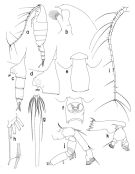 issued from : T. Park in Bull. Scripps Inst. Oceanogr. Univ. California, San Diego, 1995, 29. [p.129, Fig.19]. Female: a, habitus (left side); b, forehead (left); c, urosome (left); d, e, f, genital somite (left, dorsal, ventral, respectively); g, caudal rami (ventral); h, left caudal ramus (ventral); i, A1; j, A2; k, Md; gfl = genital flange; peg = posterior edge of genital field. Nota: Rostrum large, pointing downward. Distal margin of prosome rounded and provided with a dense bunch of long hairs. Laterally, genital prominence high, with both genital flange and posterior edge of genital field produced distally into conspicuous lobes. Ventral margin of genital flange straight or only slightly convex and somewhat obique to long axis of body. Posterior margin of genital prominence sloping about 45° with respect to long axis of body. Posterior ventral wall of somite behind genital prominence characteristically short. left side of genital somite with a low ridge close to posterior margin of genital prominence (which can be seen more clearly when viewed ventrally). Dorsally, genital somite symmetrical, widest about 3/5 length of somite from proximal end. Ventrally, genital field symmetrical, ovoid across somite. Appendicular caudal seta alittle more than 1.5 times length of 4th marginal caudal seta which is about 2.5 times length of 5th marginal cauda. A1 extending beyond distal end of prosome by last 4 segments (when applied closely to body).
|
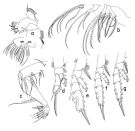 issued from : T. Park in Bull. Scripps Inst. Oceanogr. Univ. California, San Diego, 1995, 29. [p.130, Fig.20]. Female: a, Mx1 (first inner lobe separated), posterior; b, Mx2 (fifth lobe and endopod separated), posterior; c, Mxp (coxa posterior, the rest anterior); d, P1; e, P2; f, P3; g, P4. P1-4 = legs 1-4 (anterior). ase = anterior seta; pse = posterior seta. Nota: Outermost seta of basis of Mx1 relatively well developed. 1st endopodal segment with 7 setae. Outer lobe with 9 setae, of which 2 proximal ones are relatively short.
|
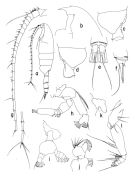 issued from : T. Park in Bull. Scripps Inst. Oceanogr. Univ. California, San Diego, 1995, 29. [p.131, Fig.21]. Male: a, habitus (left side); b, forehead (left); c, d, last pedigerous and genital somites (left, right, respectively); e, caudal rami (ventral); f, left caudal ramus; g, A1; h, A2; i, Md; j, Mx1; k, Mx2; l, Mxp (coxa posterior, the rest anterior).
|
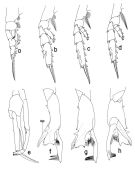 issued from : T. Park in Bull. Scripps Inst. Oceanogr. Univ. California, San Diego, 1995, 29. [p.132, Fig.22]. Male: a, P1; b, P2; c, P3; d, P4; e, P5; f, exopod of left P5 (anterior); g, idem (anterior, tutled counterclockwise); h, idem (medial, tilted clockwise); P1-4 = legs 1-4 (anterior); dgp = digitiform process.
|
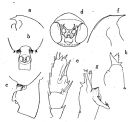 issued from : O. Tanaka in Publs Seto Mar. Biol. Lab., 1958, VI (3). [p.341, Fig.68]. As Pareuchaeta malayensis. Female: a, forehead (lateral left side); b, last thoracic segment and genital somite (ventral); c, idem (lateral left side); d, genital field (ventral); e, exopod of P2. Nota: The urosome segments and furca are in the proportional lengths as 45:20:18:5:12 = 100. In Indian specimens A1 reaches only the distal corner of the last thoracic segment. A Scott's specimen has a long A1 reaching the mifddle of the 2nd urosome segment. Male: f, forehead (lateral right side); g, segment 2 of exopod of left P5; h, anterior aspect of the same segment. Nota: The urosome segments and furca are in the proportional lengths as 19:27:21:15:6:12 = 100. A1extends beyond the end of the thoracic segment by last 2 segments.
|
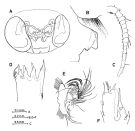 issued from : O. Tanaka & M. Omori in Publs Seto Mar. Biol. Lab., 1968, XVI (4). [p.242, Fig.13]. As Pareuchaeta malayensis. Female: A, genital complex (ventral); B, last thoracic segment and genital somite (part.) (lateral right side); C, proximal part of A1; D, biting edge of Md; E, Mx1; F, distal part of exopod of P2. Nota: The urosome segments and furca are in the proportional lengths as 43:23:21:2:11 = 100. Prosome and urosome are in the proportional lengths as 73 to 27.
|
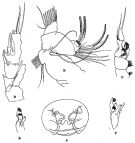 issued from : R.B.S. Sewell in The John Murray Expedition, 1933-34, Scientific Reports, VIII (1), 1947. [p.122, Fig.27]. Female (from central Arabian Sea): A, genital complex (ventral); B, Mx1; C, P1; D, P2. Nota: The proportional lengths of the cephalothorax and abdomen as 68 to 32. The proportional lengths of the various segments of the body (cephalon to caudal rami) as 283:146:88:93:70:128:74:65:7:46 = 1000. The posterior thoracic margin is rounded and provided with a dense bunch of long hairs. Head and 1st pediger segment separate, 4th and 5th fused; In the stained specimen a narrow line of fusion can be seen betwen thoracic segments 4 and 5; the dorso-lateral spine on segment 5 is absent. Genital segment closely resembles that of P. sarsi Farran. The ventral aspect of the 3rd, 4th and 5th urosomal segments are furnised with long hairs, and the caudal rami hairy on the ventral and lateral aspects. On the dorsal part of the posterior margin of the 3rd urosomal segment is a group of 2 or 3 large spinules. Anal segment very short, telescoped into the 4th segment. In Mx1 the outer lobe bears 7 large setae and posteriorly 2 other smaller ones; exopod with 11 setae; Inner lobe 1 with 12 setae, lobes 2 and 3 each with 1 stout seta; the 2nd basal segment with 5 setae, of which the inner and outemost very small; the 1st endopodal segment with 5 setae, of which 2 are stout and are spined along one margin, yhe combined 2nd and 3rd segments bear 3 setae, of which the middle one is small and the 1st and 3rd are stout, and spined along both margins; at the base of these setae on endopod 2-3 is a group of fine hair-like spinules. Male: E, clasping organ of left P5; F, idem (another view).
|
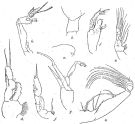 issued from : R.B.S. Sewell in Mem. Indian Mus., 1929, X. [p.162, Fig.62]. Female (from S India): a, forehead (lateral); c, Mxp; d, P1. Male: b, posterior thoracic margin and genital segment (lateral right side); e, P1; f, P2; g, P5; h, P5 (right leg); j, terminal part of right P5.
|
 issued from : A. Scott in Siboga-Expedition, 1909, XIX a. [Plate XVIII, Figs.1-8]. As Paraeuchaeta barbata. Female (from Banda Sea): 1, habitus (dorsal); 2, forehead (lateral); 3, last thoracic and genital segments (left side); 4, A1; 5, part of one of the distal hairs of Mxp; 6, P1; 7,
P2; 8, part of terminal spine (exopodite of P3)
|
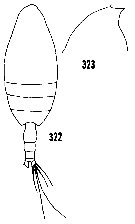 issued from : H.B. Owre & M. Foyo in Fauna Caribaea, 1967, 1, Crustacea, 1: Copepoda. [p.54, Figs.322-323]. As Euchaeta malayensis. With doubt. Female (from 25°33'N, 79°48'W)): 322, habitus (dorsal); 323, forehead (lateral). Nota: One female collected (820-418 m). This is a new record for the western North Atlantic. The length is much longer than the females examined by Sewell (1929) and Tanaka (1958). Prosome constitutes 76 p.100 of the total length and the urosome 24 p.100. Thus the length of the urosome is contained in the anterior body 3.23 times compared with 2.115 times as reported by Sewell, and 2.3-2.5 times by Tanaka. The A1 extend back to the proximal part of the 5th thoracic segment, not to the distal part or to the middle of the 2nd urosomal segment. Unfortunately, P2 are missing.
|
 Paraeuchaeta malayensis Paraeuchaeta malayensis Female: 1 - See key to species Groups and independent species of Paraeuchaeta (p.30): malayensis species Group. 2 - Outer spine of 2nd exopodal segment (or the 2nd of the first 2 exopodal segments forming a proximal, compound segment) of P1 normally developed. 3 - Outer lobe of Mx1 with 7 large distal setae extending laterad and 2 medium-sized, densely plumose proximal setae extending proximad along lateral side of appendage (Fig.20-a). 4 - Genital segment without conspicuous conical processes on left side at anterior base of genital prominence. 5 - Laterally, rostrum spiniform. 6 - Laterally, posterior ventral wall of genital somite very short (Fig.19-d). 7 - Laterally, posterior margin of genital prominence longer than posterior ventral wall of genital somite (Fig.19-d).
| | | | | Compl. Ref.: | | | Sewell, 1948 (p.330, 530, 540, 541, 552, 531); De Decker & Mombeck, 1964 (p.13); Suarez-Morales & Gasca, 1998 a (p.109); Razouls & al., 2000 (p.343, Appendix); Hernandez-Trujillo & Esqueda-Escarcega, 2002 (in Appendix) | | | | NZ: | 8 | | |
|
Distribution map of Paraeuchaeta malayensis by geographical zones
|
| | | | | | | | | | | |  Chart of 1996 Chart of 1996 | |
 Issued from : M. Madhupratap & P. Haridas in J. Plankton Res., 12 (2). [p.312, Fig.5]. Issued from : M. Madhupratap & P. Haridas in J. Plankton Res., 12 (2). [p.312, Fig.5].
Vertical distribution of calanoid copepod (mean +1 SE), abundance No/100 m3. 45- As Euchaeta (= Paraeuchaeta) malayensis.
Night: shaded, day: unshaded.
Samples collected from 6 stations located off Cochin (India), SE Arabian Sea, November 1983, with a Multiple Closing Plankton Net (mesh aperture 300 µm), in vertical hauls at 4 depth intervalls (0-200, 200-400, 400-600, 600-1000 m). |
| | | | Loc: | | | South Africa (E), ? Barbados Is., G. of Mexico, Florida (Miami) (in Owre & Foyo, 1967), ? [ Jamaica (in Webber & Roff, 1995) ], Arabian Sea, Indian, off E Sri Lanka, Bay of Bengal, Andaman Sea (Barren Island), Indonesia-Malaysia, China Seas (South China Sea, East China Sea), Japan (Izu region), off W Guatemala, off Ecuador, off Peru, off Chile, Sub-Antarct. (SE Pacif., Drake Passage) (in Yamanaka, 1976, p.171) | | | | N: | 17 | | | | Lg.: | | | (3) F: 7,3-6,4; M: 6,5-6,2; (5) F: 7,5; (11) F: 7-6,8; (29) F: 7,5-7; M: 5,6; (99) F: 7,2-6; M: 6,19; ? (140) F: 9,7; {F: 6,00-7,50; M: 5,60-6,50} | | | | Rem.: | The locality record for Antarctica needs confirmation (Sampling depth (Antarct.): 600-1000-4000 m). For Park (1995) this form would be strictly Indo-Pacific and collected this species in the Bay of Bengal, the Malay Archipelago, the South and East China seas, along the Pacific coast of Japan up to 35°18'N, and throughout the equatorial Pacific from the Malay Archipelago to the west coast of South America, where the species occurred between 2°N and 12°S off Ecuador and Peru.
Tanaka's (1958, p.312) specimens are closer to the specimen of P. barbata A. Scott, 1909 (= malayensis) from Malay Archipelago than to P. malayensis Sewell taken from the Indian Seas.
Its presence in the Caribbean-Gulf of Mexico, if it was confirmed, could be due to the isolation resulting from the closing of the Isthmus of Panama. Hernandez-Trujillo & Esqueda-Escarcega, 2002 (in Appendix) inventory the presence of this species in the Gulf of Mexico and the Caribbean Sea. | | | Last update : 07/12/2020 | |
|
|
 Any use of this site for a publication will be mentioned with the following reference : Any use of this site for a publication will be mentioned with the following reference :
Razouls C., Desreumaux N., Kouwenberg J. and de Bovée F., 2005-2025. - Biodiversity of Marine Planktonic Copepods (morphology, geographical distribution and biological data). Sorbonne University, CNRS. Available at http://copepodes.obs-banyuls.fr/en [Accessed November 29, 2025] © copyright 2005-2025 Sorbonne University, CNRS
|
|
 |
 |














